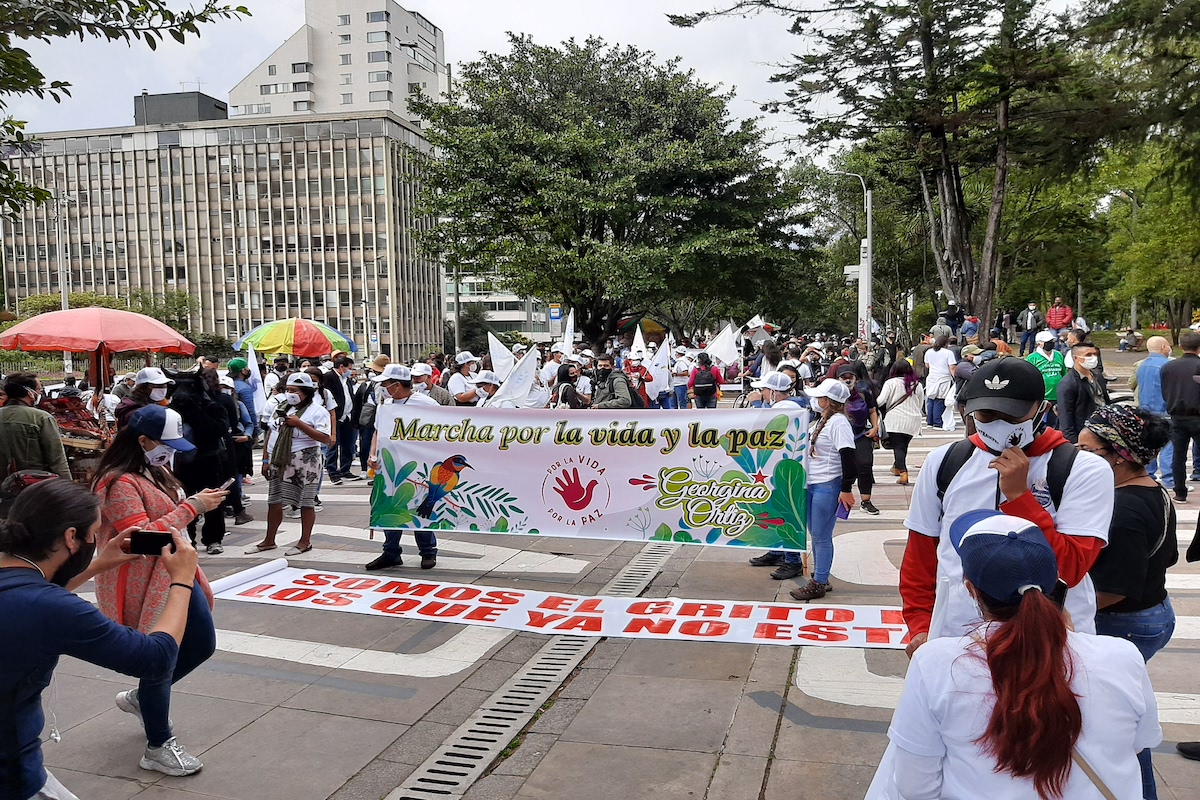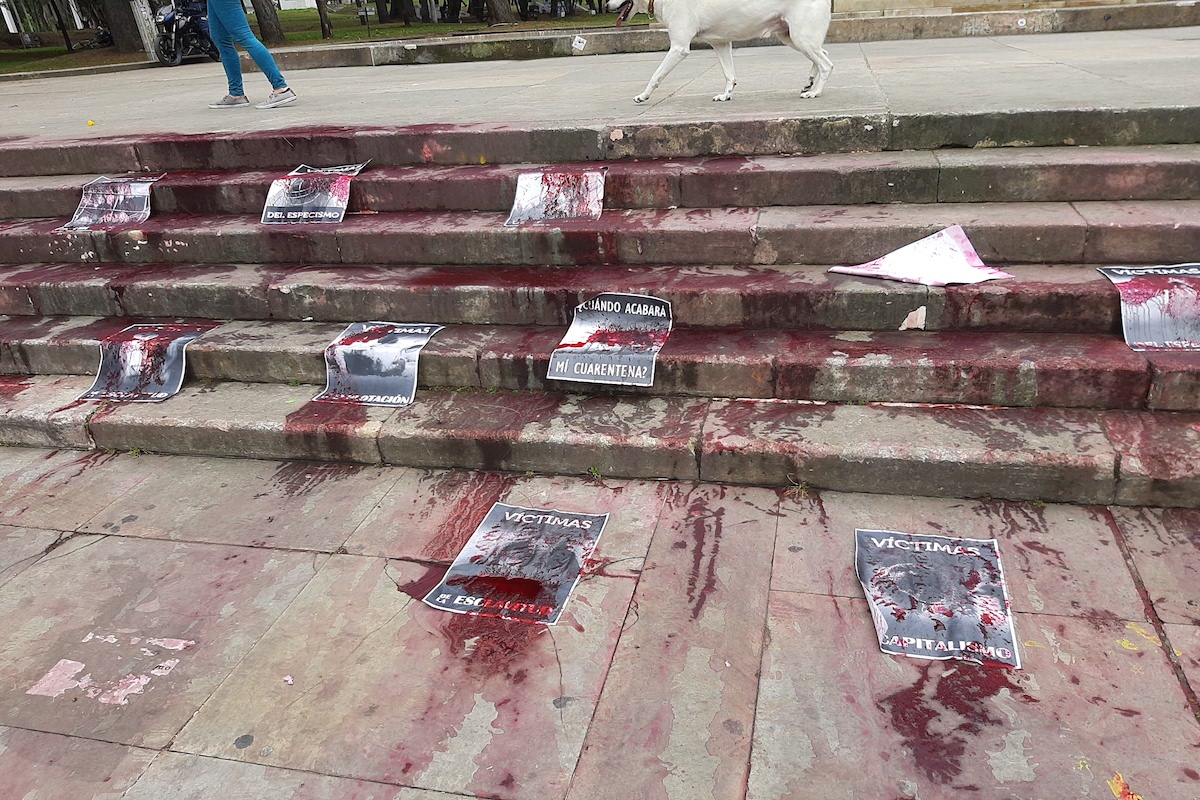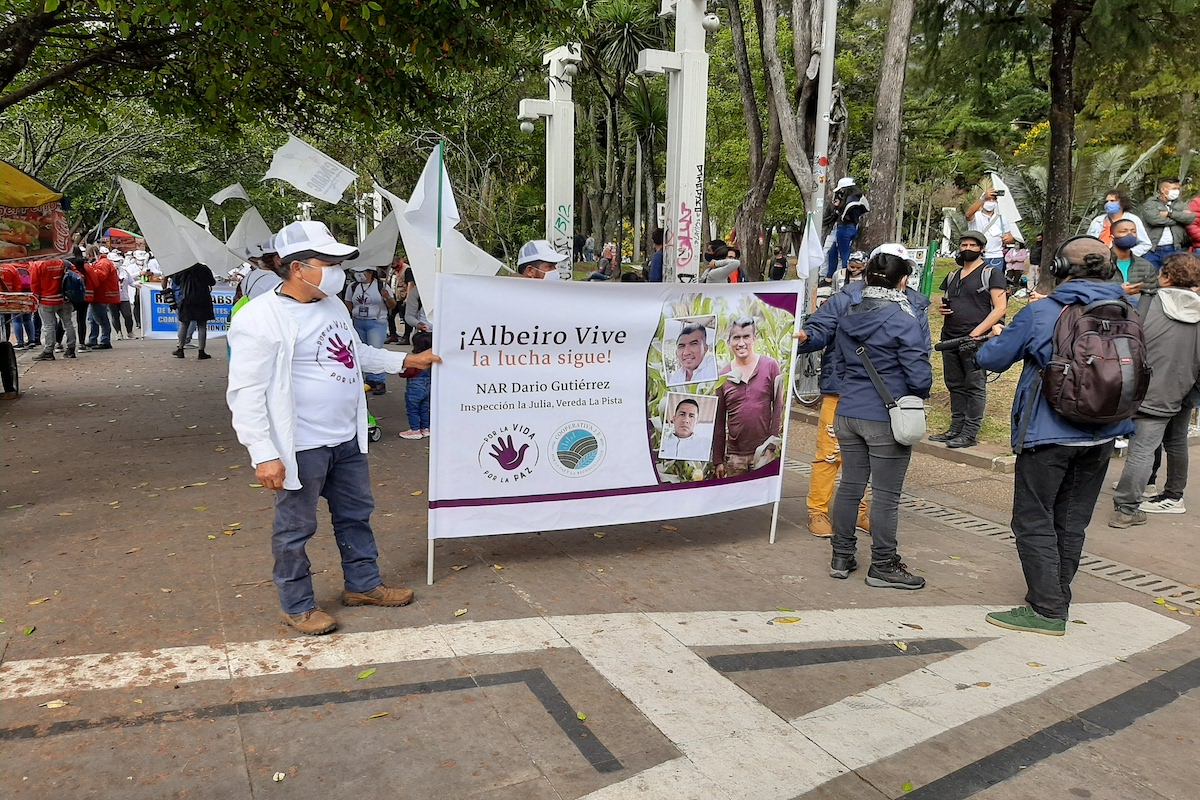

(Photo by Thomas Power)
BOGOTÁ — Diego Méndez had already spent more than 10 years at war in the Colombian conflict as a guerrilla for the Revolutionary Armed Forces of Colombia (FARC-EP) when it signed a peace agreement with the Colombian government in late 2016. He, along with 7,000 other FARC fighters who demobilized, began a transition from war to peace and a reincorporation to civilian life. Wanting to involve himself in post-conflict Colombia, Mendez joined the new FARC political party in the capital of Bogotá.
Four years later, FARC ex-combatants and their families are being assassinated as illegal armed groups compete for territorial control. To call attention to this violence and to the precarious situation of the peace agreement, Méndez and his comrades —who refer to themselves as “signers of peace” to reduce stigmatization— recently took part in a pilgrimage across Colombia.
#AEstaHora damos inicio a la Comisión de Paz del @SenadoGovCo, para escuchar a los Peregrinos que se movilizaron #PorLaVidaYPorLaPaz.
Sigan la transmisión en vivo en Facebook ??https://t.co/Txn7LjAJyq pic.twitter.com/U55WsHwJ77
— Sandra Ramírez (@SandraFARC) November 4, 2020
Somos firmantes de paz y no queremos más muertes. #PorLaVidaYPorLaPaz pic.twitter.com/cbjdO2pvh0
— FARC #PorLaVidaYPorLaPaz ? (@PartidoFARC) October 25, 2020
“We did this pilgrimage for life and peace to call attention to the assassinations that have been happening since the signing of the peace agreement. Tragically, more than 200 committed ‘signers of peace’ have been killed in Colombian territory,” Méndez said.
Desde la firma del Acuerdo hemos reafirmado nuestra íntima convicción de que no estamos solos. Somos Miles y millones los que creemos y trabajamos #PorLaVidaYPorLaPaz de Colombia ??? pic.twitter.com/qf4VKz4Y9p
— FARC #PorLaVidaYPorLaPaz ? (@PartidoFARC) November 4, 2020
In Colombia’s National Park, Méndez was organizing and preparing for the arrival of the other FARC members and organizations accompanying them from the territories. People were carrying white flags, had signs demanding a stop to the violence against ex-combatants, and had laid down placards on top of red paint signifying blood on the steps leading into the park.
“During the pilgrimage, speaking with those who signed the peace agreement, people are feeling really uncertain. There has been a lack of commitment to and fulfillment of the agreement by the government, and there is a lot of pain and grief for the loss of their brothers. The peace agreement was about change but unfortunately the reality is that the context is very complicated in many regions,” said Edwin Mosquera, a human rights defender working with the project “De la Guerra a la Paz” (From War to Peace), a project with the Lutheran Church of Colombia. He accompanied the FARC members from the Antioquia department to Bogotá.


(Photo by Thomas Power)
The peace agreeement signed in 2016 had six main points, from rural development to political participation. Among some of the programs and laws the agreement created were security guarantees for the ex-combatants.
“We want the government to fulfill the entirety of the accords, to guarantee the life of the ‘signers of peace’ but also to guarantee the life of social leaders and communities that inhabit the territories and who are victims of threats, displacement, and assassinations,” FARC congressman Omar de Jesús Restrepo Correa, alias “Olmedo Ruiz,” said. He had been a FARC commander since the 1980s, and now is a congressman for their political party in the Colombian Congress. “This process of reincorporation has been happening amid a conflict—amid a war in which territories that we used to control have been cooptated and are being used by other types of armed actors.”
Systematic Assassinations
In their quarterly report to the UN security council submitted in September, the UN verification mission of the peace process determined that 50 ex-combatants have been killed this year alone. Since the 2016 peace agreement, there have been 297 attacks against demobilized FARC—including 224 homicides, 20 disappearances, and 53 homicide attempts.
FARC leaders have also been targeted. On August 28, Jorge Iván Ramos was assassinated, one of the highest-ranking demobilized FARC to be killed. In mid-October, another leader, Juan de Jesús Monroy Ayala, known as Albeiro Suárez, was killed along with one of his bodyguards in a rural area on Colombia’s eastern plains in the Meta department. Only months earlier, he had denounced threats from paramilitary groups to the transitional justice mechanism, the Special Peace Jurisdiction (JEP).
The UN report also signals security concerns for the 24 “Territorial Spaces of Training and Reincorporation” in 13 departments throughout the country. Reincorporation zones on the Pacific Coast in Cauca, on the southern border in Putumayo, and on the eastern plains in Meta are specifically threatened. In Ituango, Antioquia, where 11 ex-combatants have been killed, threats to ex-combatants and their families became so severe they evacuated and moved to a different reincorporation zone. The FARC considers this a forced displacement.
These departments have suffered some of the highest levels of massacres and assassinations of social leaders, especially Antioquia and Cauca. The reincorporation zones are caught between armed groups competing for territorial control, who use such violence to instill fear into populations and better consolidate their territorial control.
“These armed actors are dominating the countryside, and those who benefit from war in this country are large drug traffickers, large landowners, and international business. They want the countryside to be empty of peasant farmers, they want to displace people and then enter and install large projects,” Congressman Restrepo Correa said.
There is a geographical coincidence between some of the FARC’s reincorporation zones that have faced violence and protentional economic projects. In Ituango, the Canadian company “Minerales de Córdoba” has solicited mining titles in the same village the FARC were reincorporating. There are extensive oil interests in Putumayo. Buenos Aires is the second highest gold producing municipality in Cauca, and the 30th in the country. Near the reincorporation zones in Meta, oil pipelines and infrastructure projects are being constructed.
“There are a series of economic interests that motivate these actors, and the mafias generate a series of mercenaries, of assassins, and other armed actors to defend these interests,” Congressman Restrepo Correa said.
Illegal Armed Groups
The presence of multiple illegal armed groups in Colombia represent a serious threat to the successful implementation of the peace agreement.
The Institute for Development and Peace Studies “Indepaz” found that “narco-paramilitary” groups have increased their territorial presence since 2014. Indepaz defines “narco-paramilitary” groups as illegal armed groups dedicated to drug trafficking and other illegal economies and who oftentimes have links to the armed forces. In 2019, they were present in 22.5% of Colombia’s municipalities, up from 16% in 2014.
Some regions are more impacted than others. Indepaz detected presence of narco-paramilitaries in 40% of Antioquia’s municipalities, up from 28% in 2014. In Meta, they found narco-paramilitary groups increased to 50% of the territory from 45% in 2014. In Cauca, by 2019 they were in 31% of the department and in Putumayo 38.4%.
There are also FARC frentes, fronts or divisions, that didn’t demobilize or that remobilized. Indepaz characterized those that never demobilized or became disillusioned with the peace agreement as dissidents, and those who rearmed to take advantage of illicit economies or provide security for drug traffickers are residual groups. The dissident and residual groups were mostly present in large swaths of the south part of the country.
In some regions —such as Ituango, Antioquia, where the reincorporation zone was evacuated— these armed groups compete for territorial control.
Prior to their demobilization, negotiators from the FARC had foreseen the risks narco-paramilitary groups would pose to the implementation of the peace agreement. They included a series of measures to dismantle these groups, measures which included the conformation of an elite police unit and a special division of the public prosecutor’s office.
However, according to Notre Dame’s Kroc Institute, which monitors the peace agreement’s implementation, “more than 60 measures included in the Final Accord as part of a system focused on the prevention and reduction of political violence have been implemented in a fragmented and unorganized way, with very low participation.”
Avoiding Another Cycle of Violence
Those dedicated to the successful implementation of the peace agreement, such as Diego Méndez, hope to avoid repeating the failures of previous peace processes.
“We don’t want to repeat the peace agreeement from 1984 when the day after, there was a genocide against the Unión Patriotica (UP). We don’t want that to happen again,” Méndez said.
The UP was a political party founded after peace talks between the FARC-EP and Colombian president Belisario Betancur. While the talks ultimately failed, the UP continued growing and had some initial electoral success. The reaction by the Colombian right wing and paramilitary groups was brutal—according to the Colombian National Center for Historical Memory, over 6,000 UP candidates and supporters were killed between 1985-1990, including presidential candidates.
Recently, the government met with some of the leaders of the pilgrimage to hear their recommendations. The FARC political party proposed 15 measures, from access to rights to security guarantees. In response to the pilgrimage, the government has claimed they are very concerned about the security of the ex-combatants.


(Photo by Thomas Power)
Back in Colombia’s National Park, the crowd started to swell as participants of the pilgrimage began to arrive to Bogotá. All were wearing facemasks, balancing the need to protect themselves from the Covid-19 virus while exercising their right to public protest. They spread a banner across the highway saying “We struggle for life and peace” and others carried signs saying “Albeiro Lives! The struggle continues!” referring to the assassinated FARC leader from Meta. Diego Méndez looked over the crowd and said, “Colombia can’t be destined to war forever.”
***
Thomas Power is an investigator and writer based in Bogotá, Colombia. He is a candidate for a master’s in Political Studies from Colombia’s National University and was an International Human Rights accompanier with Fellowship of Reconciliation. Twitter: @ahbueno55.



[…] Read the full story at Latino Rebels […]
[…] with 59 homicide attempts and 21 enforced disappearances. Last November, the FARC political party held a pilgrimage to Bogotá to call attention to the violence, yet 14 have already been killed this […]